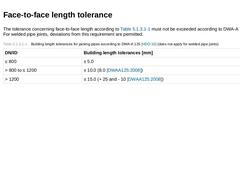
|
The tolerance concerning face-to-face length according to Table 49 must not be exceeded according to DWA-A 125 [HDD-10]. For welded pipe joints, deviations from this requirement are permitted. (Table: Table 49: Building length tolerances for jacking pipes according to DWA-A 125) |
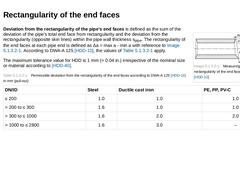
|
(Image: Measuring the rectangularity of the end faces of the pipe)Deviation from the rectangularity of the pipe’s end faces is defined as the sum of the deviation of the pipe’s total end face from rectangularity and the deviation from the rectangularity (opposite skin lines) within the pipe wall thickness spipe. The rectangularity of the end faces at each pipe end is defined as Δa = max a - min a with reference to Figure 213. According to DWA-A 125 [… |
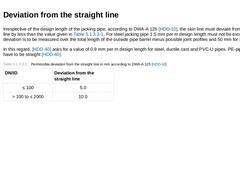
|
Irrespective of the design length of the jacking pipe, according to DWA-A 125 [HDD-10], the skin line must deviate from the straight line by less than the value given in Table 51. For steel jacking pipe 1.5 mm per m design length must not be exceeded. The deviation is to be measured over the total length of the outside pipe barrel minus possible joint profiles and 50 mm for side inlets. In this regard, [HDD-40] asks for a value of 0.9 mm per m design … |
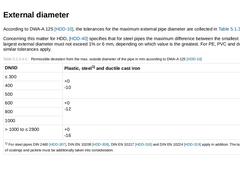
|
According to DWA-A 125 [HDD-10], the tolerances for the maximum external pipe diameter are collected in Table 52. Concerning this matter for HDD, [HDD-40] specifies that for steel pipes the maximum difference between the smallest and the largest external diameter must not exceed 1% or 6 mm, depending on which value is the greatest. For PE, PVC and ductile cast iron, similar tolerances apply. (Table: Table 52: Permissible deviation from the max. outside … |
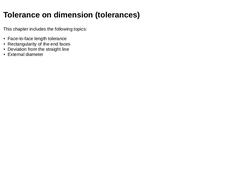
|
Meeting the tolerance on dimension or tolerances of the jacking pipes used for HDD is of special importance for creating a high-quality pipe connection as well as for the transfer of the pullback forces when pulling-in. Furthermore, the functionality of the later pipeline is influenced regarding its leak tightness, operational safety and the flow conditions, for example. |
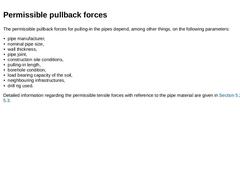
|
The permissible pullback forces for pulling-in the pipes depend, among other things, on the following parameters: -
pipe manufacturer,
-
nominal pipe size,
-
wall thickness,
-
pipe joint,
-
construction site conditions,
-
pulling-in length,
-
borehole condition,
-
load bearing capacity of the soil,
-
neighbouring infrastructures,
-
drill rig used.
Detailed information regarding the permissible tensile forces with reference to the pipe material are given in (… |
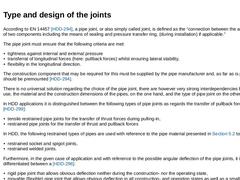
|
According to EN 14457 [HDD-294], a pipe joint, or also simply called joint, is defined as the “connection between the adjacent ends of two components including the means of sealing and pressure transfer ring, (during installation) if applicable.” The pipe joint must ensure that the following criteria are met: -
tightness against internal and external pressure
-
transferral of longitudinal forces (here: pullback forces) whilst ensuring lateral stability,
|
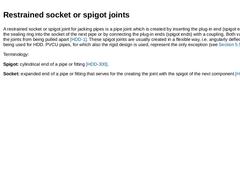
|
A restrained socket or spigot joint for jacking pipes is a pipe joint which is created by inserting the plug-in end (spigot end) through the sealing ring into the socket of the next pipe or by connecting the plug-in ends (spigot ends) with a coupling. Both variants prevent the joints from being pulled apart [HDD-1]. These spigot joints are usually created in a flexible way, i.e. angularly deflectable when being used for HDD. PVCU pipes, for which … |
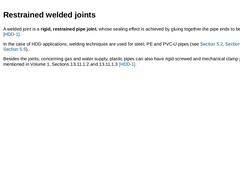
|
A welded joint is a rigid, restrained pipe joint, whose sealing effect is achieved by gluing together the pipe ends to be joined [HDD-1]. In the case of HDD applications, welding techniques are used for steel, PE and PVC-U pipes (see (Steel pipes), (PE-pipes) as well as (PVC-U-pipes)). Besides the joints, concerning gas and water supply, plastic pipes can also have rigid screwed and mechanical clamp joints that are mentioned in Volume 1, Sections 13.11.1.2 … |
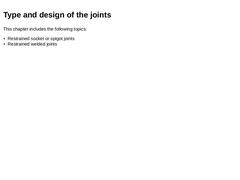
|
According to EN 14457 [HDD-294], a pipe joint, or also simply called joint, is defined as the “connection between the adjacent ends of two components including the means of sealing and pressure transfer ring, (during installation) if applicable.” The pipe joint must ensure that the following criteria are met: -
tightness against internal and external pressure
-
transferral of longitudinal forces (here: pullback forces) whilst ensuring lateral stability,
|
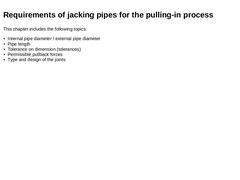
|
(Image: Possible mechanical strain of the pipe coating while pulling-in)Even today, there are neither national nor European standards that define general requirements of jacking pipes irrespective of the type of pipe. A first attempt at this is the EN 12889 [HDD-9] that, in an extremely restricted form in Section 5.2 “Pipes and joints” for drains and sewers, is formulated as follows: “Installation shall not commence before the following criteria have … |
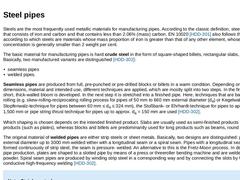
|
Steels are the most frequently used metallic materials for manufacturing pipes. According to the classic definition, steel is an alloy that consists of iron and carbon and that contains less than 2.06% (mass) carbon. EN 10020 [HDD-301] also follows this definition, according to which steels are materials whose mass proportion of iron is greater than that of any other element, whose carbon concentration is generally smaller than 2 weight per cent.… |
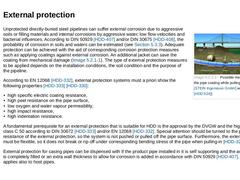
|
(Image: Possible mechanical strain of the pipe coating while pulling-in)Unprotected directly-buried steel pipelines can suffer external corrosion due to aggressive soils or filling materials and internal corrosions by aggressive water, low flow velocities and bacterial influences. According to DIN 50929 [HDD-407] and/or DIN 30675 [HDD-408], the probability of corrosion in soils and waters can be estimated (see (External protection)). Adequate protection … |
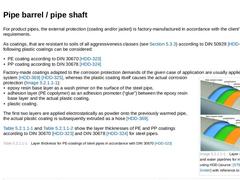
|
For product pipes, the external protection (coating and/or jacket) is factory-manufactured in accordance with the client’s requirements. As coatings, that are resistant to soils of all aggressiveness classes (see (External protection)) according to DIN 50929 [HDD-407] the following plastic coatings can be considered: -
PE coating according to DIN 30670 [HDD-323]
-
PP coating according to DIN 30678 [HDD-324]
(Image: Layer structure of gas and water pipelines … |
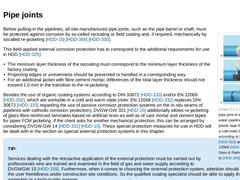
|
(Image: Recoating a pipe joint of a PE-coated water pipeline by means of a plastic tape that is workable in a cold state (one-tape system) according to DIN 30672 and/or DIN EN 12068)Before pulling-in the pipelines, all site-manufactured pipe joints, such as the pipe barrel or shaft, must be protected against corrosion by so-called recoating or field coating and, if required, mechanically by socalled re-jacketing [HDD-15] [HDD-359] [HDD-330]. This … |
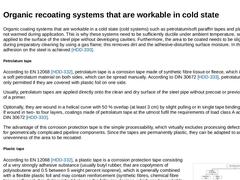
|
Organic coating systems that are workable in a cold state (cold systems) such as petrolatum/soft paraffin tapes and plastic tapes are not warmed during application. This is why these systems need to be sufficiently ductile under ambient temperature, so they can be applied to the surface of the steel pipe without developing cavities. Furthermore, the area to be coated needs to be slightly heated during preparatory cleaning by using a gas flame; this … |
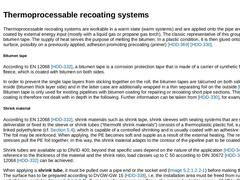
|
Thermoprocessable recoating systems are workable in a warm state (warm systems) and are applied onto the pipe area to be coated by external energy input (mostly with a liquid gas or propane gas torch). The classic representative of this group is the bitumen tape. The supply of heat serves the purpose of melting the bitumen. In a plastic condition, it is then glued onto the pipe surface, possibly on a previously applied, adhesion promoting precoating (… |
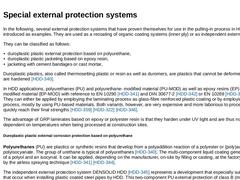
|
In the following, several external protection systems that have proven themselves for use in the pulling-in process in HDD are introduced as examples. They are used as a recoating of organic coating systems (inner ply) or as independent external protection. They can be classified as follows: -
duroplastic plastic external protection based on polyurethane,
-
duroplastic plastic jacketing based on epoxy resin,
-
jacketing with cement bandages or cast mortar,
|
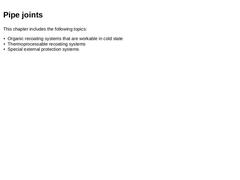
|
(Image: Recoating a pipe joint of a PE-coated water pipeline by means of a plastic tape that is workable in a cold state (one-tape system) according to DIN 30672 and/or DIN EN 12068)Before pulling-in the pipelines, all site-manufactured pipe joints, such as the pipe barrel or shaft, must be protected against corrosion by so-called recoating or field coating and, if required, mechanically by socalled re-jacketing [HDD-15] [HDD-359] [HDD-330]. This … |
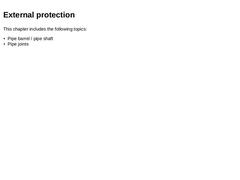
|
(Image: Possible mechanical strain of the pipe coating while pulling-in)Unprotected directly-buried steel pipelines can suffer external corrosion due to aggressive soils or filling materials and internal corrosions by aggressive water, low flow velocities and bacterial influences. According to DIN 50929 [HDD-407] and/or DIN 30675 [HDD-408], the probability of corrosion in soils and waters can be estimated (see (External protection)). Adequate protection … |
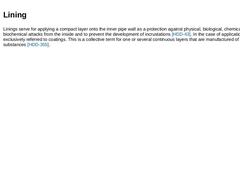
|
Linings serve for applying a compact layer onto the inner pipe wall as a protection against physical, biological, chemical and/or biochemical attacks from the inside and to prevent the development of incrustations [HDD-43]. In the case of application at hand it is exclusively referred to coatings. This is a collective term for one or several continuous layers that are manufactured of coating substances [HDD-355]. |
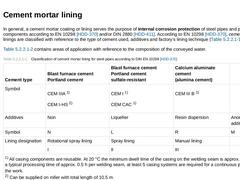
|
In general, a cement mortar coating or lining serves the purpose of internal corrosion protection of steel pipes and pipeline components according to EN 10298 [HDD-370] and/or DIN 2880 [HDD-411]. According to EN 10298 [HDD-370], cement mortar linings are classified with reference to the type of cement used, additives and factory’s lining technique (Table 61). Table 62 contains areas of application with reference to the composition of the conveyed … |
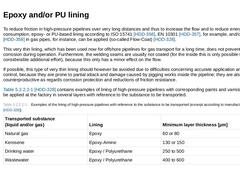
|
To reduce friction in high-pressure pipelines over very long distances and thus to increase the flow and to reduce energy consumption, epoxy- or PU-based lining according to ISO 15741 [HDD-356], EN 10301 [HDD-357], for example, and/or API RP 5L2 [HDD-358] in gas pipes, for instance, can be applied (so-called Flow-Coat) [HDD-328]. This very thin lining, which has been used now for offshore pipelines for gas transport for a long time, does not prevent … |
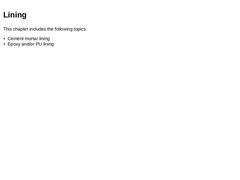
|
Linings serve for applying a compact layer onto the inner pipe wall as a protection against physical, biological, chemical and/or biochemical attacks from the inside and to prevent the development of incrustations [HDD-43]. In the case of application at hand it is exclusively referred to coatings. This is a collective term for one or several continuous layers that are manufactured of coating substances [HDD-355]. |
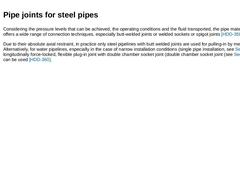
|
Considering the pressure levels that can be achieved, the operating conditions and the fluid transported, the pipe material steel offers a wide range of connection techniques, especially butt-welded joints or welded sockets or spigot joints [HDD-359]. Due to their absolute axial restraint, in practice only steel pipelines with butt welded joints are used for pulling-in by means of HDD. Alternatively, for water pipelines, especially in the case of … |